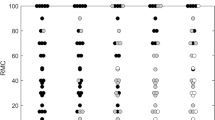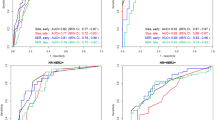Abstract
The purpose of this study was to assess the usefulness of ultrasonography (US) in the assessment of the breast following primary medical therapy (PMT) of large operable breast cancer. A total of 52 patients were studied; all had invasive breast cancer, confirmed by core biopsy, with initial size > 4 cm by palpation, T2-3, N0-1, M0. PMT was with epirubicin, cisplatin and continuous infusional 5-fluorouracil, as previously described (Jones et al, 1994, J Clin Oncol 12: 1259-1265). Independent clinical and US assessments were made during PMT before surgery or biopsy. A total of 31 (60%) patients achieved complete clinical response (cCR), but in only five of these was the post-treatment ultrasound normal. Post-treatment sonographic findings of diffuse parenchymal distortion or a mass lesion without Doppler signal were associated with more favourable histology (pathological CR, non-invasive or microinvasive carcinoma), whereas a mass with Doppler positivity was more often associated with residual macroscopic invasive carcinoma. Patients who did not achieve cCR had a high incidence of residual macroscopic carcinoma (71%) regardless of the sonographic characteristics. With median follow-up of 27 months (range 12-43), ten (19%) patients have relapsed and six (12%) have died, but only one relapse has occurred within treated breast. Ultrasonography is a sensitive technique for assessing the response to PMT, particularly in patients who achieve cCR. It may be helpful in selecting those patients who do not require post-PMT surgery and in localizing abnormalities in those who do, particularly in those with cCR. However, clinicians should be aware that a residual US abnormality is by no means pathognomonic of residual cancer.
This is a preview of subscription content, access via your institution
Access options
Subscribe to this journal
Receive 24 print issues and online access
$259.00 per year
only $10.79 per issue
Buy this article
- Purchase on Springer Link
- Instant access to full article PDF
Prices may be subject to local taxes which are calculated during checkout
Similar content being viewed by others
Author information
Authors and Affiliations
Rights and permissions
About this article
Cite this article
Seymour, M., Moskovic, E., Walsh, G. et al. Ultrasound assessment of residual abnormalities following primary chemotherapy for breast cancer. Br J Cancer 76, 371–376 (1997). https://doi.org/10.1038/bjc.1997.392
Issue Date:
DOI: https://doi.org/10.1038/bjc.1997.392
This article is cited by
-
Mammasonographie
Der Gynäkologe (2010)
-
Sentinel lymph node biopsy after neoadjuvant chemotherapy in a patient with operable breast cancer
Surgery Today (2008)
-
Wertigkeit der Mammasonographie im Rahmen der Brustkrebsheilung
Der Gyn�kologe (2004)



